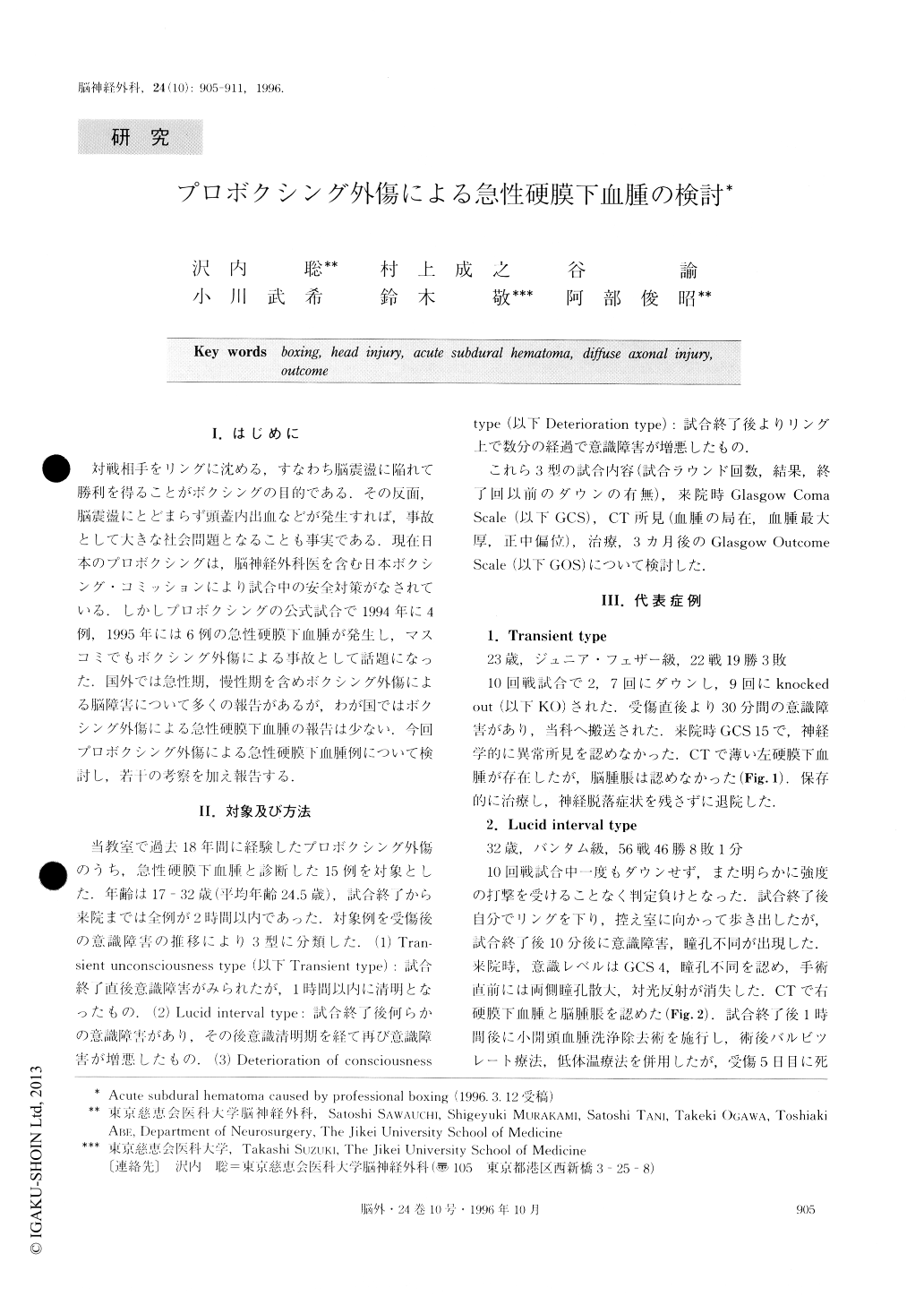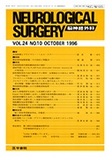Japanese
English
- 有料閲覧
- Abstract 文献概要
- 1ページ目 Look Inside
I.はじめに
対戦相手をリングに沈める,すなわち脳震盪に陥れて勝利を得ることがボクシングの目的である.その反面,脳震盪にとどまらず頭蓋内出血などが発生すれば,事故として大きな社会問題となることも事実である.現在日本のプロボクシングは,脳神経外科医を含む日本ボクシング・コミッションにより試合中の安全対策がなされている.しかしプロボクシングの公式試合で1994年に4例,1995年には6例の急性硬膜下血腫が発生し,マスコミでもボクシング外傷による事故として話題になった.国外では急性期,慢性期を含めボクシング外傷による脳障害について多くの報告があるが,わが国ではボクシング外傷による急性硬膜下血腫の報告は少ない.今回プロボクシング外傷による急性硬膜下血腫例について検討し,若干の考察を加え報告する.
Knockout in boxing entails deliberate production of the state of unconsciousness. Acute subdural hematoma which is the most common acute brain injury in box-ing, accounts for 75% of all acute brain injuries and is the leading cause of boxing fatalities. The aim of this study is to evaluate acute subdural hematoma caused by professional boxing by analyzing the content of bouts, the level of consciousness on admission, CT scan, therapy and outcome 3 months after admission.
Fifteen boxers who had suffered from acute subdural hematoma were classified into three groups according to the pattern of loss of consciousness. Transient un-consciousness type (Transient type): boxers who had returned to alertness within an hour from the time of injury. Lucid interval type: neurological deterioration appeared with a lucid interval from ten minutes to an hour after knockout. Deterioration of consciousness type (Deterioration type): A state of unconsciousness appeared and worsened from a few minutes after knockout.
Analyzing the number of rounds in bouts indicated that the hematoma occurred most frequently in bouts of 10 rounds. All of our subjects presented subdural hema-tomas without cerebral contusions on CT scan. With re-gard to the location of the hematomas, 9 hematomas in-volved the left side, 3 the right, 2 the suboccipit and 1 the interhemisphere. Transient type was found in 7 pa-tients who had GCS scores of 19, 15 on admission. Since CT scan revealed thin subclural hematoma with or without mild midline shift, conservative therapy was carried out in all patients. All patients had a good re-covery. Five patients of lucid interval type with an admission GCS score of 4, 6 and 7 demonstrated thick-er hematoma compared to that presented by the tran-sient type with significant midline shift on CT scan. All patients required surgery. Outcome of this type was good recovery (n=2), moderate disability (n=1), per-sistent vegetative state (n=1), death (n=1). Three pa-tients of deterioration type had GCS scores of 5, 6. Be-cause of subdural hematoma with remarkable midline shift on CT scan, all patients underwent surgery. Out-come was good recovery (n=1), moderate disability (n=1), persistent vegetative state (n=1). Overall out-come was good recovery 66.7%, moderate disability 13.3%, persistent vegetative state 13.3%, death 6.7%. Furthermore, 8 patients who underwent surgery with aGCS score of less than 8 exhibited good recovery 37.5%, moderate disability 25%, persistent vegetative state 25%, death 12.5%.
CT scan of lucid interval and deterioration type showed a tendency to show thick subdural hematoma and remarkable midline shift compared to transient type. Outcomes of lucid interval and deterioration type were worse than those of transient type. This result suggests that the influence of repeated head injury and diffuse brain injury might make a difference between these groups. Repeated head injury means that further impacts repeatedly damaged the injured brain afterbleeding in the bouts. Overall outcome was better than that published in previous reports and also than that observed in other head injuries, for example, traffic accident and fall. The reasons for this could be that the patients were younger, that there was immediate sur-gical treatment, and that brain injury without cerebral contusion had contributed to better outcome.
Finally, the best medical management intervention seems to be to diagnose and treat the lesions as early as possible after occurrence of subdural hematoma.

Copyright © 1996, Igaku-Shoin Ltd. All rights reserved.


